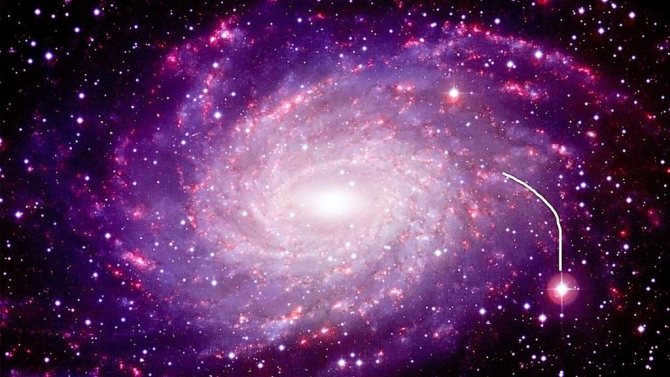
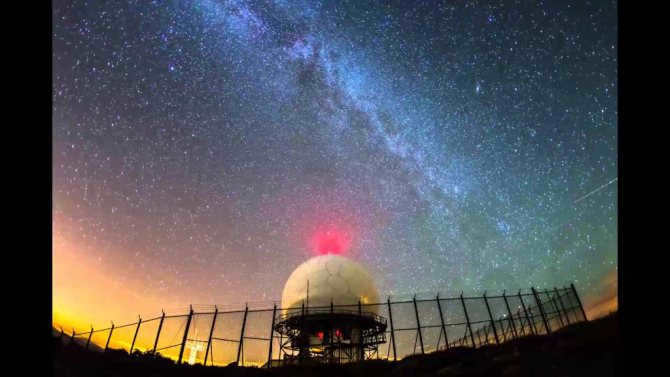



Orienteering using the North Star, Polaris, is the most well-known method of orienteering in the Northern Hemisphere. Polaris is the star closest to the Earth’s axis of rotation among all the stars visible to the naked eye, and its position in the night sky changes slightly compared to other celestial bodies.
Because of its proximity to the Earth’s axis of rotation, Polaris always points north and accurately indicates the direction to it. Therefore, using Polaris as a reference remains one of the most reliable methods when compasses or GPS devices are not available.
Furthermore, unlike a magnetic compass, which relies on the Earth’s magnetic poles, Polaris can be used to determine the direction to the northern geographic pole. The magnetic compass points to the magnetic pole, which is approximately 500 km away from the geographic pole, resulting in less precise readings compared to those provided by Polaris.
Additionally, Polaris deviates from the exact direction to the geographic north by about ±45 angular minutes throughout the day. This level of error is acceptable for orienteering tasks.
However, the practice of using celestial bodies, such as Polaris, for orienteering is typically seen as a last resort in situations where traditional navigation tools are unavailable or no longer functional.
Overview
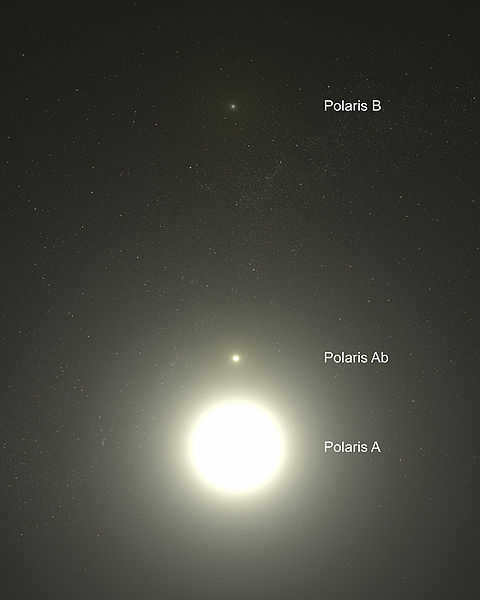
The image shows Polaris, also known as the North Star, along with its surrounding stars. This stunning photograph was taken by the Hubble Space Telescope.
Polaris is the most brilliant and nearest pulsating variable star of the Cepheus delta type to Earth, with a period of 3.97 days. However, Polaris is a highly atypical Cepheid: its pulsations diminish over a span of approximately several decades. In 1900, the variation in brightness was approximately ±8%, while in 2005 it was around 2%. Furthermore, the star has experienced an average increase in brightness of 15% during this interval.
Polaris is known as a triple star system. The central star of the system is the supergiant Polaris A (α UMi A), which shines 2000 times brighter than our Sun and has a mass 4.5 times greater than our Sun. Polaris B (α UMi B), with a mass of 1.39 solar masses, is situated at a considerable distance from Polaris A, making it easily observable through telescopes even from Earth’s surface. In 1929, the analysis of Polaris’s spectrum revealed that Alpha of the Little Bear is a close binary star, confirming earlier observations made in 1924 (Moore, J. H and Kholodovsky, E. A.)[3]. Polaris A’s companion, Polaris P (α UMi P or α UMi a or α UMi Ab), has a mass of 1.26 solar masses and is positioned so close to the supergiant that it was only captured in photographs by the Hubble telescope after the equipment was reconfigured. The estimated orbital period of Polaris P around α UMi A is around 30 years[4]. Polaris B orbits the α UMi A/P binary system over a span of approximately 100,000 years. Additionally, there are two other distant components, known as α UMi C.
And
α UMi D
however, these stars are much older and are not physically connected to Polaris[5].
It is plausible that Polaris and the stars around it are remnants of a dispersed cluster. Based on data from Hipparcos and 2MASS, the radial velocities of Polaris’ closest neighbors are almost identical, and their average distance from Earth is approximately 100 parsecs. According to the color-magnitude diagram created for the cluster, the age of its members (including Polarnaya) is estimated to be around 80 million years[6].
In 1990, the European space telescope Hipparcos estimated that Polaris was located 434 light-years away. A new estimate in 2006 suggested that it was actually 330 light-years away (Turner), and in 2008 another estimate of 359 light-years was proposed (Turner). More recent high-resolution measurements in 2012, conducted by a team of astronomers led by David Turner of St. Mary’s University in Canada using data from the Russian six-meter BTA telescope, have given a new estimate of 99 parsecs (equivalent to 323 light-years)[8].
The distance to Polaris, being a type of Cepheid, is crucial in estimating the distances to other galaxies. By refining this distance, we can improve our understanding of the distance scale and also put constraints on the mass of dark matter[9].

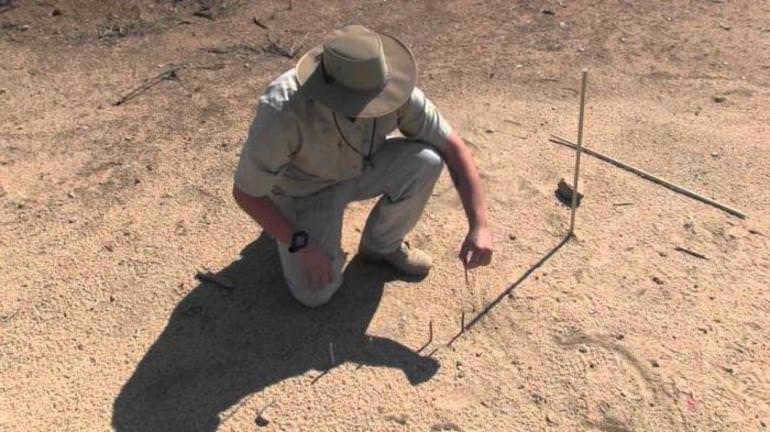
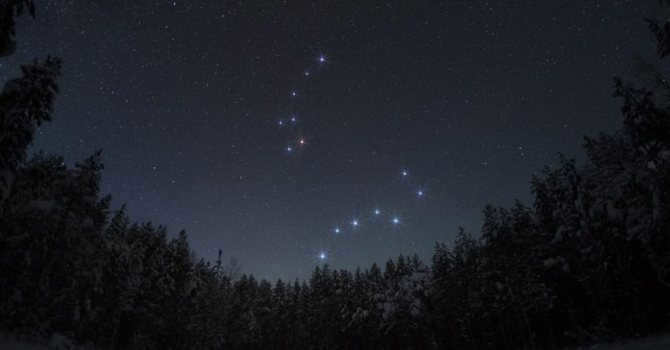

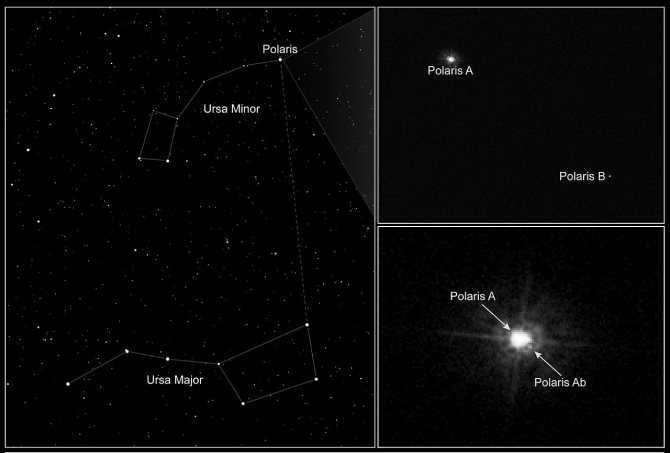
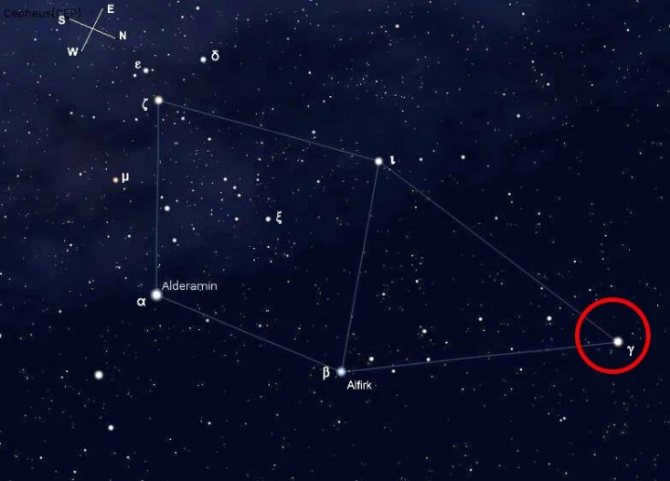
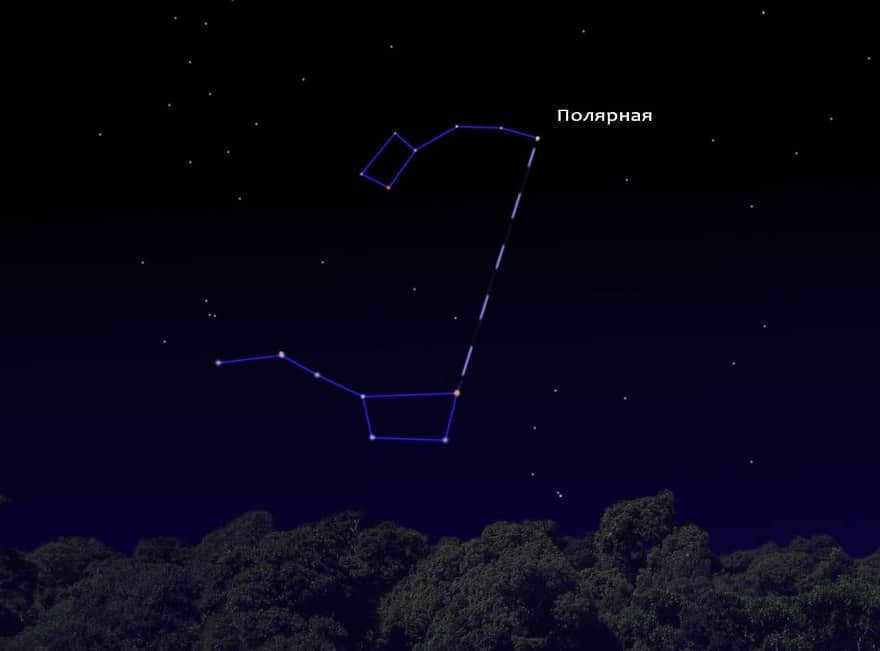
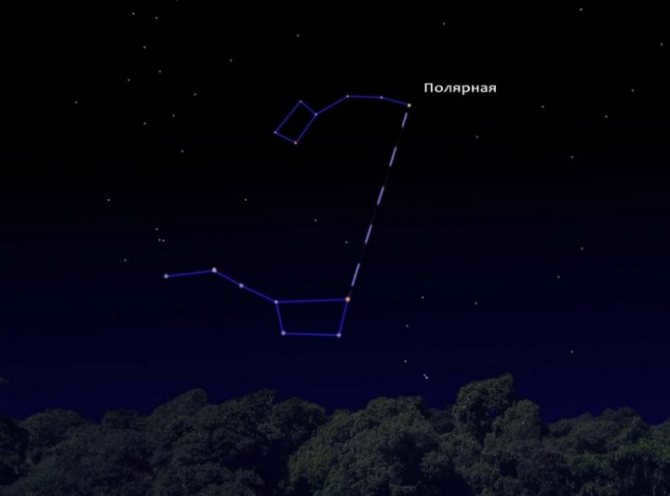
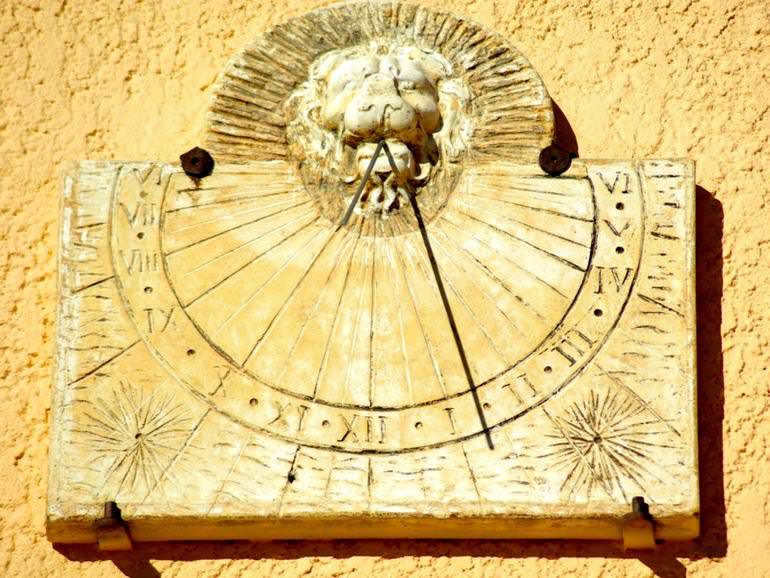

If the sky is clear, the correct direction can be determined at night by following the stars. During the day and in the morning, the Sun can be used as a guide. To navigate using the Sun, a basic understanding of geography and topography is needed.
The Sun always rises in the east and sets in the west. At noon, the shadow cast by the Sun indicates the direction west.
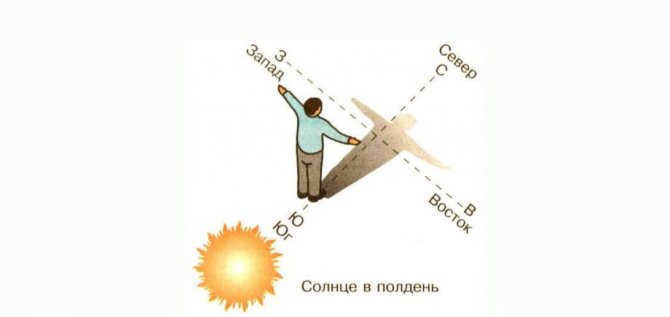
Not only is it handy for navigation, but it can also be used to tell time. In the event that you don’t have a watch or have misplaced it, you can always rely on the Sun to determine the time of day. Simply find a pole or stick and plant it vertically in the ground. Draw a clock face around the pole. Then, observe the movement of the shadow cast by the pole on the drawn dial. This will give you an approximate time. What’s fascinating is that the margin of error in this method is no greater than 10%.
Historical Background
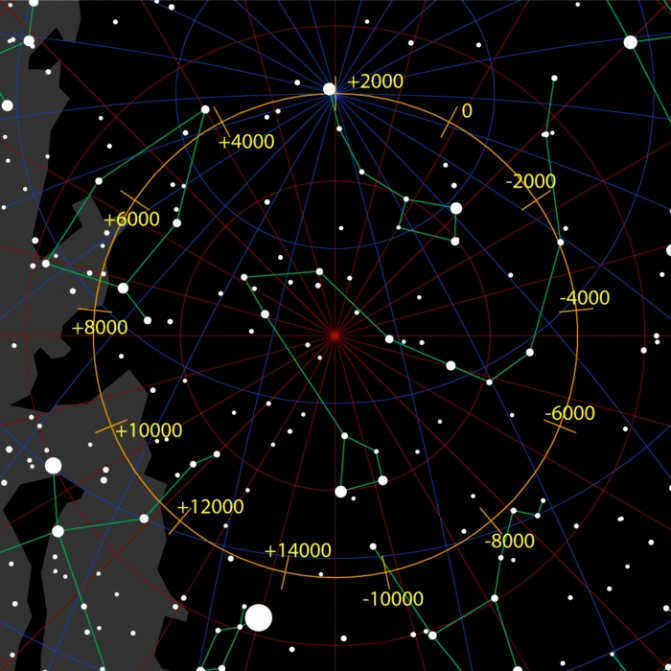
The movement of the Earth’s axis around the north pole of the ecliptic and the resulting change of polar stars occur due to the phenomenon known as luni-solar precession. This means that the Earth’s axis moves in a circular motion with a radius of 23 degrees, at an approximate rate of 1.397 degrees per 100 years. As a result, different stars take turns being the closest to the World Pole at different points in time. For instance, around 5000 years ago during the pre-dynastic period of ancient Egypt, the star Tuban (alpha of the Dragon constellation) held this position. However, during the beginning of our era, there were no bright stars near the World Pole. Looking ahead, in 2000 years, the star Alrai (gamma Cepheus) will be the closest to the World Pole, and in 12,000 years, it will be Vega (alpha Lyra).
It is worth noting that the term “Polaris” is a proper name that specifically refers to the star alpha of the Little Bear constellation.
List of polar stars throughout the full precessional circle[10]
- 13,000 BC.
– the polar star was Vega α Lyra) - 9 thousand years BC.
– the polar stars alternated between Hercules and other stars - 8-7 thousand years BC.
– the polar star was Hercules - 5500-3500 BC.
– the polar star was Dragon - 3500-1500 B.C.
– the polar star was Polaris Tuban (α of the Dragon) - 1500 B.C. to 1 A.D.
– the polar star was Polaris Kohab (β of the Little Bear). - 1-1100 A.D.
– there was no polar star. However, there were “guardians” – Kohab (β of the Little Bear) and Kinosura (α of the Little Bear), positioned at approximately the same distance from α and β of the Little Bear. - 1100-3200.
Polaris is the α of the Little Bear. It will reach its minimum distance from the north pole (0°27′34.1″) on April 23, 2102. - 3200-5000 years
– The star Alrai γ Cepheus will become polar. - 5000-6500 years
– The star Alphirk β Cepheus will become polar. - 6500-8500 years
– The star Alderamin α Cepheus will become polar. - 8500-13,000 years
– The stars Deneb α and Sadr γ of Swan will become polar. - 13,000 years
– The star Vega α of Lyra will become polar again.
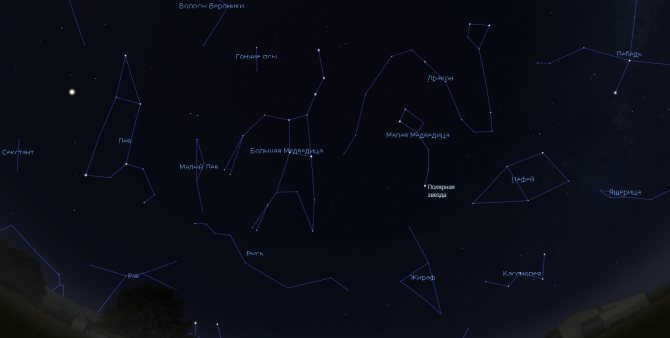
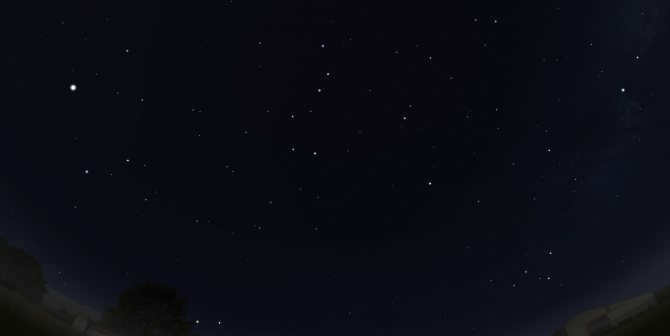

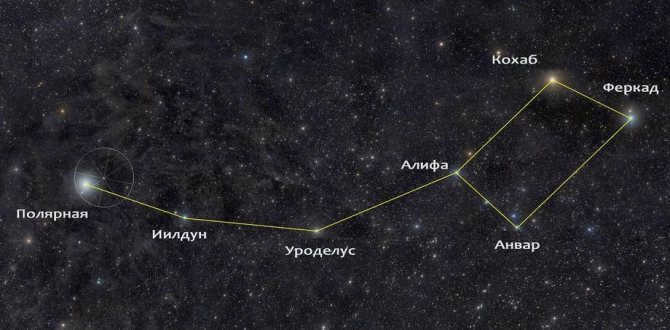

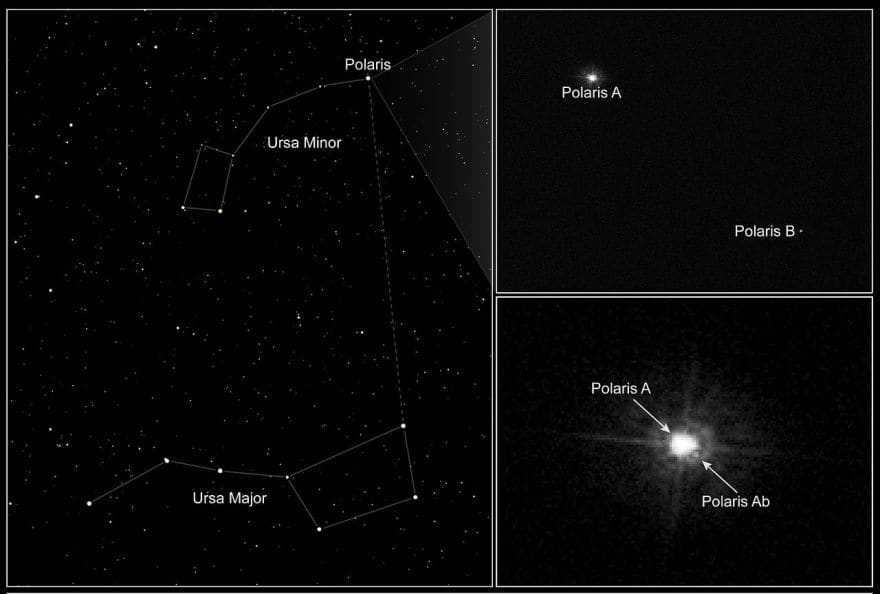
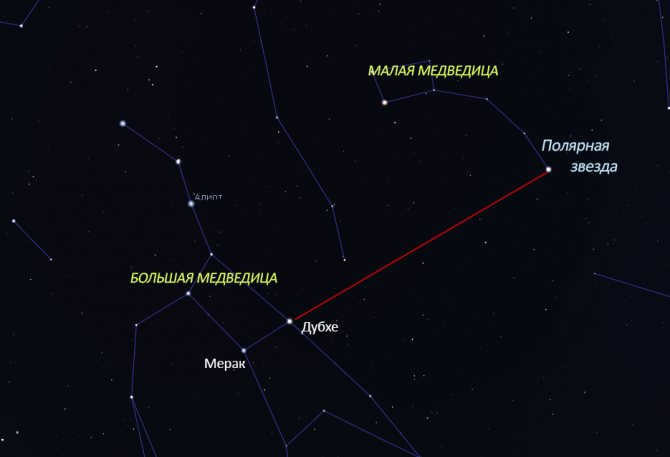
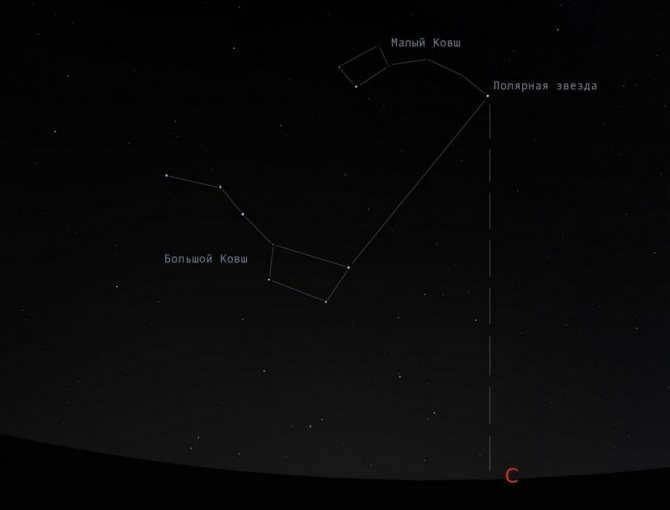
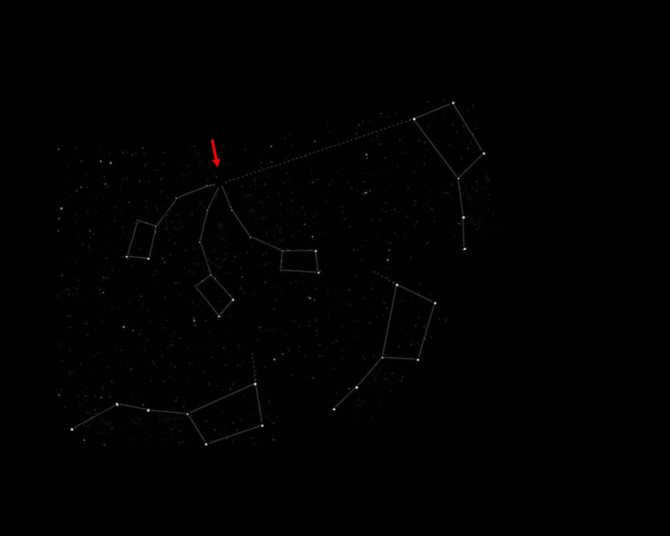
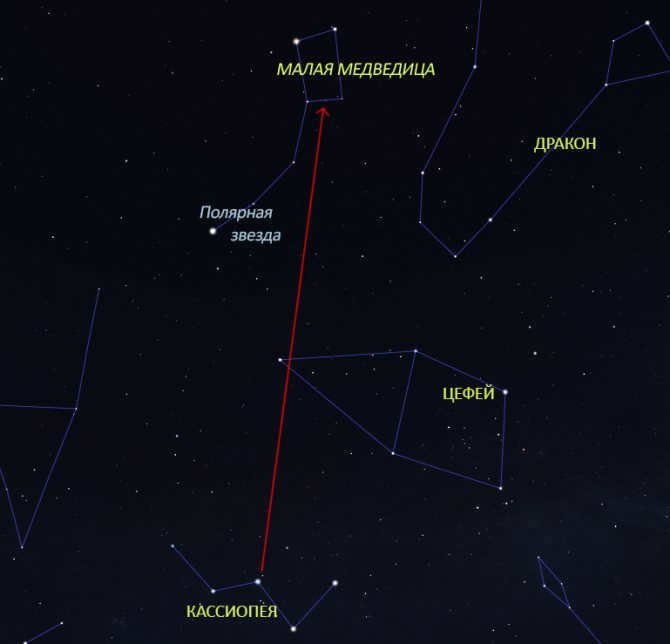
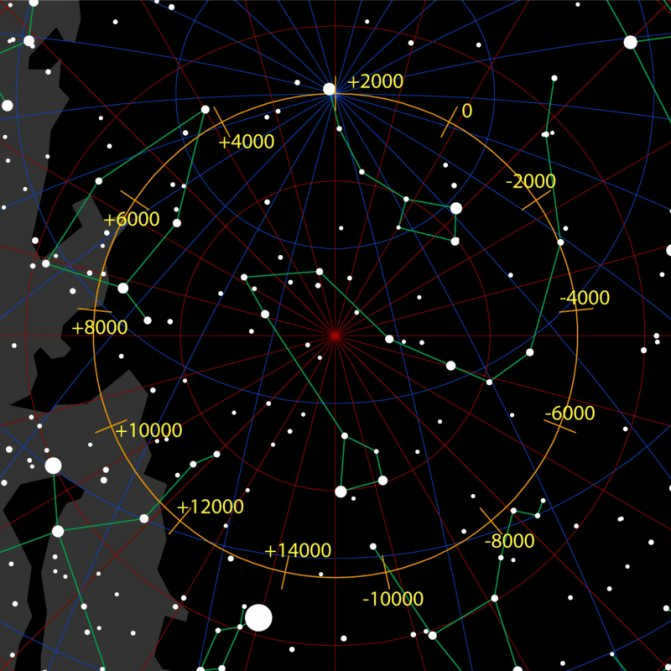
The analogy of the “nail” is highly appropriate: if you extend the hypothetical metal rod from the “cap”, the direction in which Polaris points becomes clear. This “nail” penetrates the globe precisely at the North Pole, traverses all the internal layers of the planet, and emerges at the point of the South Pole. Therefore, Polaris in the celestial sphere can be found along the extension of the Earth’s axis. It is less than 1º away from the North Pole.
Navigating the landscape with Polaris
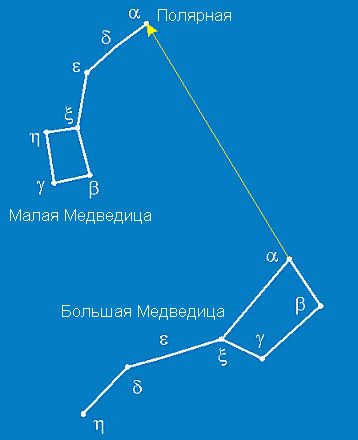
Discovering the Direction of Polaris
Polaris is consistently positioned above the northern point of the horizon in the Northern Hemisphere, providing a reliable reference for navigating through unfamiliar terrain.
To locate Polaris, it is necessary to first locate a distinct arrangement of seven luminous stars known as the Big Dipper constellation, which resembles a bucket. By identifying the two stars, Dubhe and Merak, on the “wall” of the bucket opposite the “handle,” it is possible to draw an imaginary line perpendicular to these stars. Five times the distance between these two extreme stars along this line will lead to Polaris. The direction to Polaris aligns with the north, while its altitude above the horizon corresponds to the observer’s latitude.
Pursuing the cross and blade
The preeminent constellation in the Northern Hemisphere is Orion (the Hunter), which resembles a colossal stretched bow. It is easily distinguishable by its trio of luminous stars at its core – Mintaka, Alnitaka, and Alnilam are in such close proximity that they form a line known as Orion’s belt among astronomers. It is most visible during the winter and autumn seasons, but can also be observed at daybreak in the spring and summer. By locating the Hunter’s Sword, and tracing the path from its tip, one can move in the direction of the south. By following the downward gaze from the central spark in the belt, you should be able to locate three stars that appear to be suspended from it:
- A nebula that is cloudy and blurry (known as the Orion Nebula, where new celestial objects are formed);
- A star that is bright and blazing;
- A celestial body that is faint and blinking.
By mentally merging these elements, one can perceive the shape of a sword and trace its path.
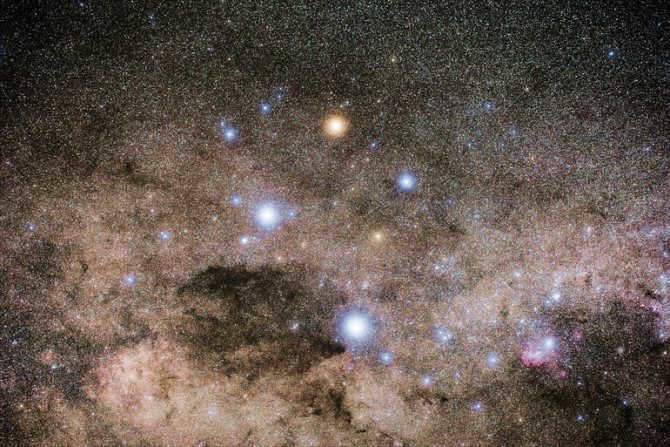
Fortunate explorers who happen to be in the Southern Hemisphere will have the privilege of witnessing the magnificent Southern Cross constellation firsthand, which is prominently featured on the flags of Australia and New Zealand. Not only is it the most brilliant constellation, but it also serves as a useful navigational tool. Comprised of four luminous stars, it is crucial not to mistake it for the False Cross, which is characterized by fainter lights and elongated proportions. To verify its authenticity, astronomers recommend identifying the two bright stars on the left. By mentally drawing a line through the vertical axis of the Cross, travelers can determine the direction of the south. To enhance accuracy in orientation, survivalists suggest the following:
- Join them together to form a segment and draw a vertical line upwards from the midpoint;
- Connect a regular line from the Southern Cross to the point of intersection.
The point where the lines intersect will indicate the south direction, allowing the determination of other directions.
Points to Consider
- Scott G. Engle, Edward F. Guinan, and Petr Harmanec
. Making Progress in Resolving the Parallax Debate of Polaris: A Precise Measurement of the Distance to Our Nearest Cepheid Using Gaia DR2 (EN), The American Astronomical Society (July 16, 2018). - Astronomers Successfully Determine the Exact Distance to Polaris (RU) (July 30, 2018).
- Polaris: Surpassing Expectations and Paving the Way for New Discoveries
- Wielen; Jahreiss; Dettbarn; Lenhardt; Schwan (2000). "Polaris: Astrometric Orbit, Position, and Proper Motion". arXiv: astro-ph/0002406
- Evans; Sasselov. Polaris: Amplitude, Period Change, and Companions
- David G. Turner.
Polaris and Its Relatives (English). arxiv.org (July 18, 2009). – Review. Verified October 17, 2009. - Astronomers are in disagreement about the exact distance to the renowned North Star, which was reported on November 30, 2012.
- New findings suggest that Polaris is actually closer than previously believed.
- The distance to the famous North Star is a topic of heated debate among astronomers.
- Astronomy // Encyclopedia for Children. – M.: Avanta+, 2007. – P. 269.
How to use the Moon for navigation
In addition to Polaris, another celestial body that can be used for navigation is the Moon, which is the Earth’s natural satellite. On a clear night, the Moon can be seen shining brightly in the sky. By observing its position, we can determine our direction. When the Moon’s sickle is rising, it means that it is located in the western part of the sky. On the other hand, when the sickle is waning, the Moon is in the eastern part of the sky. In the evening, if we see the Moon in the first quarter, it is positioned in the southern direction. And when the Moon becomes full, it is still in the southern direction, particularly during the first hour of the new day.

By 7:00 AM, you can also observe the Moon in its first quarter position in the southern part of the sky.
Different Positions of Other Constellations Throughout the Year
How can you use other constellations to navigate? They can also help you determine which direction to go. Astronomers study how the positions of constellations change. This occurs not only at night but throughout the entire year.
At midnight, if you look towards the south, you will be able to see the following constellations:
- Canis Major and Canis Minor (January)
- Leo (March)
- Capricornus (May)
- Taurus (November)
- Orion (December)
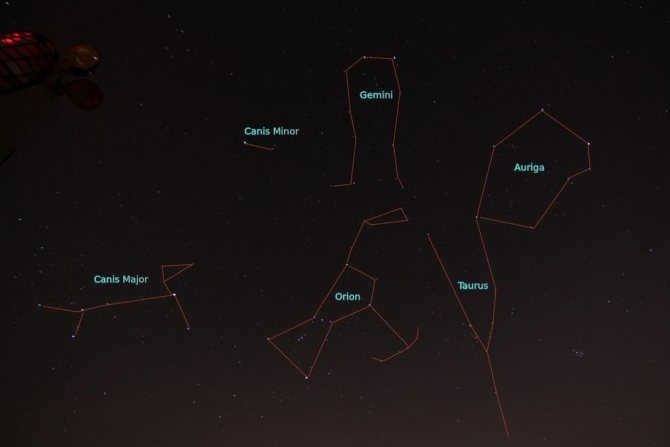
In the sky, the Polaris star, also known as the North Star, can be seen in a northerly direction from the south. It can serve as a reliable reference point and guide for navigation.
Astronomical object
Polaris is a massive star that belongs to the class of variable stars known as Cepheids. Cepheids are important celestial objects used by astronomers to measure astronomical distances. Due to its proximity, Polaris has been extensively studied and analyzed by generations of astronomers. Its variability was first suspected in 1852 and later confirmed by Einar Hertzsprung in 1911.

Over the course of more than a century, the amplitude of the 4-day brightness has been observed to decrease. From its discovery until 1963, the amplitude was greater than 0.1 star magnitude and gradually decreased. However, after 1966, it rapidly decreased to less than 0.05 star magnitude and has since fluctuated unpredictably within this range. Measurements indicate that the period of luminosity change is approximately 3.97 days and is currently increasing. The period experienced a relatively steady increase of 4 seconds per year until 1963, at which point it remained constant for 3 years before starting to rise again in 1966. Current measurements demonstrate a consistent increase of 3.2 seconds per year.
Research reveals that Polaris is now 2.5 times brighter in the sky compared to when it was observed by Ptolemy.
The coordinates of it

At present, the brightness of the Alpha star in the constellation Ursa Minor is quite moderate, with a variable apparent magnitude of 1.97. Its declination is +89°19'8” (or +89°15'51.2” during the J2000 epoch), which means it always points towards the north with an accuracy of approximately one degree. Interestingly, this star remains fixed in its position, and it cannot be seen at the equator unless atmospheric diffraction is taken into consideration. However, it is difficult to consider this as a significant observation.
Points of the Northern Hemisphere
Finally, it is probable that the northern hemisphere started to be positioned at the top simply because the majority of explorers and navigators during the Great Discovery era came from there.
Psychologists observe: we have a tendency to place everything that appears better to us higher. And one’s homeland is always better than a foreign country. Consequently, the explorers adopted maps with their own homeland depicted at the top, above the unexplored territories they were journeying to.
Presently, the “north hemispheric” perspective may be seen as snobbish by some, and scientists from various regions of the world propose a different viewpoint on the planet and its “portraits.” However, tradition still holds stronger.

In the Northern Hemisphere, there is a prominent feature that has served as a guide for those who have lost their way on numerous occasions. This feature is Polaris, which can be observed from any location and remains fixed in its position. To prevent getting lost, one simply needs to understand how to locate Polaris in the vast expanse of the night sky.
Although it may not be among the twenty brightest stars, Polaris has always served as a guiding light for humanity. It appears as if all other celestial bodies revolve around it, making it the true axis. Despite the Earth’s rotation, Polaris remains steadfast in its position, consistently pointing towards the north. This is because it is in close proximity to the North Pole. While the arrangement of stars in the sky remains unchanged for millennia, a shift in the Earth’s axis a thousand years ago gave rise to a new Polaris.
Which constellation contains Polaris?
Polaris is not the name of a specific star, but rather the designation for the star that fulfills the role of pointing north. In the present day, this role is played by Alpha of the Little Bear constellation, which is located just one degree away from the Earth’s north pole. Polaris is the brightest star in this constellation. The Little Dipper, which is part of the Little Bear constellation, is made up of 29 stars, but only seven of them are bright enough to be easily seen. These stars form the shape of a small dipper, and Polaris is located at the end of its handle.
The Little Bear constellation may not be the most prominent, ranking 56th in magnitude. However, it is noteworthy not only for being a mirror image of the Big Dipper but also because it is home to Polaris, the North Star. Polaris is the key to locating the Little Bear constellation in the night sky, making it an important celestial guide.
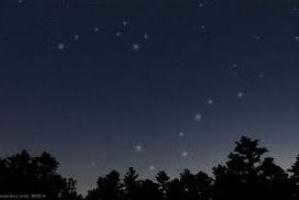
Characteristics of the polar star
The polar star, also known as Polaris, is classified as a variable star of the Cepheid type. With a pulsation period exceeding four days, it is currently in a state of relative calm. However, astronomers have determined that its brightness is increasing over time, making it much easier for modern observers to locate Polaris in the night sky. Despite its increasing brightness, the polar star is believed to be in a waning phase and is considered to be quite old.
This celestial body belongs to the category of supergiant stars. It is 23 times larger than the Sun and has a mass 4 times greater. Additionally, it shines 2,500 times brighter than our sun. It is a binary star system, however, it can only be observed with a highly powerful telescope. As a result, the second star was only discovered in the 1930s. Furthermore, in 2006, the Hubble telescope determined that it is actually a triple star system.
The star’s color has a slight yellowish tint and it is slightly hotter than the Sun. The exact distance from the Earth is still unknown. However, it is estimated to be approximately 434 light-years away.
It is possible to utilize it to establish the directions of the globe. When facing it, you will be facing the opposite direction of the north. By aligning with Polaris, you can also ascertain your geographic latitude with an accuracy of approximately one degree. To accomplish this, you will require a protractor, which should be aimed at the star, and a plumb line, which should be affixed at the center of its base. Subtracting 90 degrees from the resulting angle will yield the geographic latitude. The further north you are, the higher above the horizon the desired point will appear, and the more other celestial bodies you will observe surrounding it. By familiarizing yourself with how to locate Polaris in the night sky, you will always be able to determine your precise position.
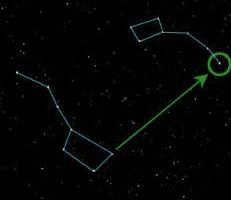
Origins of Polaris
Throughout history, the fixed position of this celestial body has captivated the attention of various cultures. The ancient Arabs believed it to be a hole in the sky, likening it to a colossal coffin in which a celestial warrior rests. In Greek mythology, it was referred to as Kinosaura, meaning the “tail of the dog.” Meanwhile, in India, a captivating legend tells of a young boy who was transformed into a star by the Gods due to his unwavering devotion to prayer. These names and legends surrounding stars and constellations have been passed down through generations, each with their own unique explanations of their origins.
Ways to locate Polaris in the celestial sky
Knowing how to find Polaris can be a lifesaver, as it serves as a constant guidepost. This star is easily visible throughout the entire night and every season in the Northern Hemisphere, consistently indicating the direction of north. To locate Polaris, begin by identifying the Big Dipper constellation. Comprised of seven prominent stars, this cluster forms the shape of a ladle. By imaginatively extending a line from the rim of this celestial container, at a length equal to five times the size of the rim, Polaris will come into view.
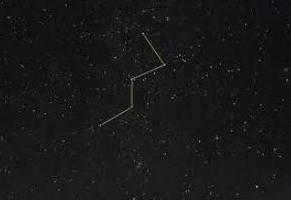
In the event that the Big Dipper is not observable, an unusual occurrence, one may utilize the Cassiopeia constellation, which bears a resemblance to the letter “M”. By joining its three prominent stars and plotting a line perpendicular to the center of this connection, at a distance four times the width of the constellation, one will be able to locate Polaris.
Polaris is likely one of the most frequently cited celestial bodies. It is referenced in works of fiction, in the logs of mariners, and in scientific investigations. The star owes its renown, and even its status as a celebrity, primarily to the guidance it provides. Its distinctive position for numerous centuries aids in orienting voyagers both at sea and on land. Moreover, it plays a pivotal role in calculating distances in outer space, and as a result, it is the subject of numerous scientific inquiries. But let’s start from the beginning.
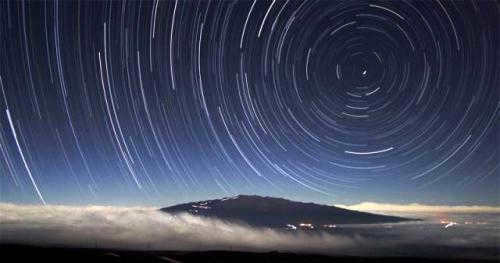
The position of Polaris, which indicates the direction, is determined by its location on the celestial sphere. When observing the stars from Earth, they appear to move around the planet, sometimes disappearing below the horizon and reappearing later. By using a camera with a slow shutter speed, it is possible to capture images showing that the stars move in circular paths of varying sizes. The smaller the diameter of the circle, the closer the star is to the celestial pole. In the Northern Hemisphere, there is a fixed point at the center of these circular paths, known as Polaris. It has been referred to by different names, such as the North Nail, Prick Star, Iron or Heavenly Stake, and Golden Pile.
Characteristics of the role
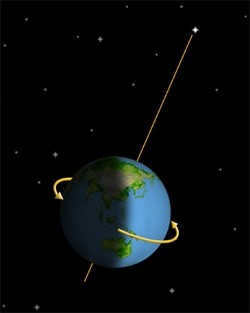
The metaphor of the “nail” is highly effective: if you extend the imaginary metal rod from the “hat,” it becomes clear in which direction Polaris points. This “nail” pierces the globe precisely at the North Pole, traverses all the inner layers of the planet, and emerges at the South Pole. Thus, Polaris in the sky is positioned along the Earth’s axis extension. It is less than 1° away from the North Pole.
It should be highlighted that the movement of Polaris is identical to that of other celestial bodies. The apparent fixed position it holds for us is a result of its placement on the extension of the Earth’s axis. In reality, the stars move quite rapidly, not only due to their own motion, but also because of the planet’s rotation. As the Earth revolves around its axis, it presents different sides to the stars. Only the stars positioned above the poles consistently observe the same portion of the Earth’s surface. Interestingly, the South Pole also has its own polar star – Sigma Octantha – although it is significantly fainter than the others. Nevertheless, it is possible that this arrangement could change in the future.
Polaris, also known as the North Star, has been serving as a reliable guide for navigation since around 1100 AD. However, its position will gradually shift away from the pole of the world starting in 2100. This rotation of the main pointer is a natural result of the motion of stars and a phenomenon known as the precession of the Earth’s axis. The Earth’s axis itself also undergoes a circular movement, slowly tracing out circles due to the shape of the globe and the gravitational force. This complete circle takes nearly 26 thousand years to complete.
Around 15,000 years ago, Vega, the brightest star in the Lyra constellation, served as the Northern Nail. In approximately 11,000 years, it will once again assume this position. Polaris will soon be replaced by Alrai (Gamma Cepheus) by the year 3200. By 5000, Alrai will be succeeded by Beta of the same constellation, Alfirk. Then, in 6500, Alderamin (Alpha Cepheus) will take over. Between the years 8500 and 13,000, Deneb and Sadr of the Swan constellation will occupy the position of Polaris.
What is the method of locating Polaris?
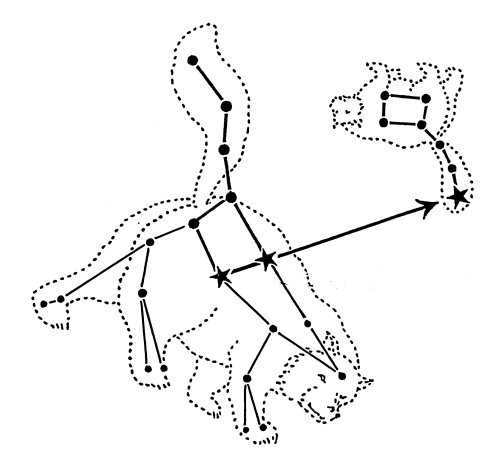
There is a persistent misconception surrounding the North Star, stemming from its fame and popularity. Many believe that this star should be one of the brightest in the sky, if not the brightest. However, this is not the case. Polaris is situated in the constellation Ursa Minor and while it does stand out among its stellar companions in the constellation, it ranks as only the 46th brightest point in the entire night sky. Therefore, it is crucial to know how to locate Polaris.
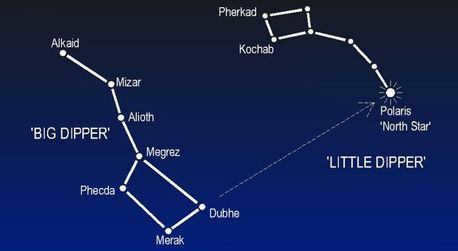
The main point of reference for determining direction is the constellation known as the Big Dipper. This constellation is familiar to nearly everyone from a young age. In order to locate the North Star, one must mentally connect a straight line between the two outermost stars of the Big Dipper, namely Dubge and Merak. If you extend this line for a distance approximately equal to five segments between Dubge and Merak, you will find Polaris at the end. Polaris is located at the tip of the tail of the Little Bear.
The North Nail has served as a convenient landmark due to its close proximity to the world pole. Polaris, unlike any other compass, accurately indicates the north. Determining the cardinal directions is a simple task: just drop a perpendicular line from Polaris to the surface. When facing Polaris, the south will be directly behind you, the east to your right, and the west to your left.
Polaris not only acts as a compass pointing to the north, but it also provides information about the latitude of a particular area. In order to determine the latitude, one must measure the altitude of Polaris above the horizon. A lower altitude indicates a location closer to the equator. At the North Pole, Polaris is directly overhead at the zenith. Conversely, at the equator, Polaris appears to be on the horizon. Sailors in centuries past used the angle between Polaris and the horizon in the northern direction to navigate, chart, and adjust their course.
On other planets
In the immense expanse of the cosmos, there exist numerous counterparts to our celestial pole, Polaris. The rotation around an axis is an inherent characteristic of all planets, and thus, if one were to observe the motion of stars from their surfaces, it would be effortless to identify fixed reference points denoting the South and North poles. In the case of Mercury, for instance, the polar star is Omicron of the Serpentine, while its southern equivalent is Alpha of the constellation Hagiographus. Even the Moon possesses a North Nail, which manifests as Delta of the Goldfish.
Importance in the field of astronomy
Polaris, also known as Alpha Ursae Minoris, possesses a multitude of distinct characteristics that set it apart. One notable feature is its periodic pulsations, which classify it as a Cepheid variable. Cepheids are known for their fluctuations in luminosity, temperature, and size. Polaris has a pulsation period of 3.97 days. Despite these changes, they are not readily observable from our vantage point on Earth.
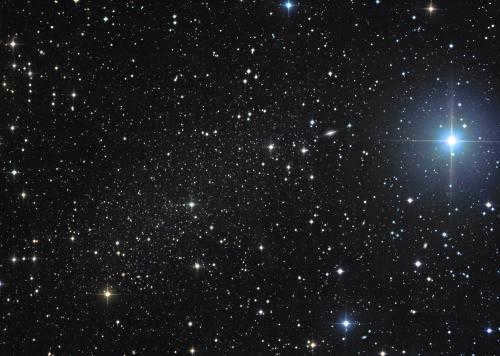
Research has demonstrated a correlation between the period of pulsation and the brightness of Cepheids. It has been discovered that as the period increases, the luminosity becomes more pronounced. This relationship is utilized in the field of astronomy to ascertain the distance to remote celestial bodies. Considering that Polaris is the nearest Cepheid to the Solar System, its significance in these calculations cannot be overstated, particularly given that the precision of data diminishes with greater distance from the periodic star.
Unconventional
The unique nature of Polaris has attracted the attention of numerous researchers. Upon further examination, it was discovered that the Cepheid variable known as the North Nail is far from ordinary. Its pulsations possess a peculiar characteristic: they gradually diminish. Towards the end of the previous century, there was speculation that in the early 2000s, this star could potentially cease to be classified as a Cepheid, a phenomenon that had never been observed in scientific history. However, this theory did not come to fruition. In 1993, the fluctuations in pulsation amplitude ceased, and, notably, the star also became 15% brighter during this time period.
Cosmic eternity
In order to ascertain the distance to celestial entities that are far away, information regarding the brightness and position of all neighboring Cepheids is utilized. By employing this technique, in the initial portion of the previous century, the renowned Edwin Hubble established the distance to the Andromeda Nebula and demonstrated the presence of additional galaxies. At present, this approach is employed in order to compute the magnitude of numerous stellar “communities”. Furthermore, it serves as the foundation for our contemporary comprehension of the vastness of the Universe.

A slight complication
However, there is a slight complication. Currently, researchers do not agree on the exact distance to Polaris. The widely accepted measurement of over 400 light-years was determined by the Hipparcos satellite in 1990. However, this estimation has undergone some changes in recent years. Initially, it was revised downward to 330 light-years, then later increased to 359 light-years. Finally, in 2012, David Turner proposed a new estimate of 323 light-years.
Astronomical characteristics
The general orientation indicated by Polaris is not significantly influenced by its cosmic properties. However, it is these properties that can be seen as compensating for the relatively low brightness of such a crucial celestial body for navigation purposes.
Polaris is more brilliant and larger in size compared to the Sun. It falls into the category of supergiants and has a radius 46 times greater than that of the Sun. The luminosity of the North Star is 2500 times more significant than the corresponding parameter of our star.
However, that’s not the end of the story: Polaris is not just any ordinary star. It is actually part of a trinary system consisting of three stars, each with their own unique size and brightness. Polaris A serves as the central star of the system, being the supergiant, while Polaris B resides at a notably distant location. In comparison, Polaris B is much smaller, weighing only 1.39 solar masses (in contrast to Polaris A’s 4.5 solar masses). In close proximity to the supergiant lies its companion, Polaris Ab, which has a mass of 1.26 solar masses. Due to the close proximity between these two stars, the “modest companion” went unnoticed for a long time, only being detected through the utilization of the Hubble telescope.
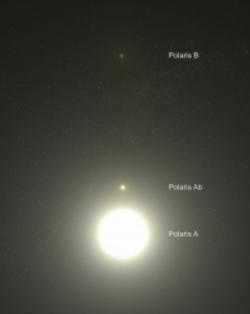
It appears that the distinctive feature of Polaris in the night sky is not just its location. The presence of an unconventional cepheid and triple system in this constellation has captured the attention of numerous astronomers and carries significant symbolism. Throughout history, the direction indicated by Polaris has served as a reliable guide for navigation during nighttime voyages across vast oceans or unfamiliar terrain.
Nowadays, with the increasing reliance on technology and electronic devices, Polaris continues to serve as a crucial reference point in the vastness of outer space. While the North Star may no longer provide direct guidance, it still plays a vital role in determining distances and holds significant value for both humankind and the scientific community. As a result, scientists are diligently working to precisely measure the distance between Polaris and the Sun, unravel the mysteries behind its fading pulsation, and not overlook the importance of this seemingly insignificant and unremarkable star in the eyes of an ordinary observer on Earth.
Centuries ago, before the compass and GPS became essential tools for navigation, people relied on the stars to guide them out of the wilderness and find their way on the open sea. Even in the modern era, with advanced technology at our fingertips, it is important not to forget the ancient wisdom of using the stars as a reliable source of direction. In today’s world, where we heavily rely on gadgets, it is easy to overlook the fact that when we find ourselves lost in the wilderness, there may be no cellular signal or we may encounter an anomalous zone that disrupts our devices. The starry sky, however, remains a constant and dependable guide, always showing us the right path.

What constellation is Polaris located in?
Polaris can be found in the handle of the Little Bear constellation, and it is positioned towards the north with a slight variation. It stands out as a brighter star compared to the others, making it more easily visible. The Little Dipper constellation contains a total of 29 celestial bodies, but only 7 of them are readily visible to the naked eye. This constellation is actually a smaller version of the Big Dipper, which consists of 56 objects, not all of which can be seen without a telescope. To accurately determine the direction indicated by the constellation, one must know how to locate Polaris.
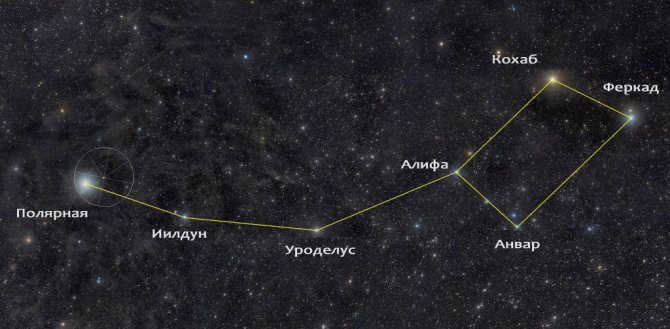
Orientation using a compass
Orientation can be achieved using a compass, which consists of a magnetized arrow that always points towards the north. The opposite side of the compass indicates the south direction. The compass dial usually has the letters N or C to represent north, and S or Y to represent south.
The compass case is movable, and it is important to align the end of the arrow with the “o” mark when using it. Before using the compass, it is essential to ensure that it is in proper working condition.
The following steps should be followed for orientation:
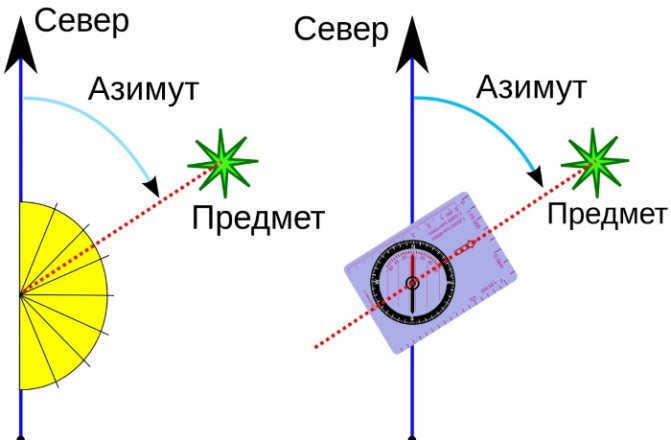

- If the lever holds the arrow in place, it should be released so that it can freely align itself in the desired position. There is no need to orient it in any particular direction.
- Allow the hand to oscillate for a moment and then return it to the same position. If it appears to have shifted slightly after settling, it indicates a defect in the apparatus.
Bring a small iron object close to the device and quickly remove it. It doesn’t have to be large; a nail will suffice.
When utilizing the instrument, it is positioned in a horizontal orientation, and the numeral N is precisely aligned with the arrow’s tip. Subsequently, a tall item is chosen at a distance situated in the path of motion. The case is uniquely labeled with a measurement scale, which allows for the determination of the direction’s azimuth. In the event of a route alteration, the identical steps are taken to ascertain the fresh azimuth.
Unique Features of Polaris
Not many people are aware of the extraordinary nature of this celestial object. Polaris is exceptionally large, surpassing even the size of the Sun. Its temperature is significantly higher, making it brighter and more massive. In reality, it is a trinary star system, although this level of detail cannot be discerned with the naked eye. The three colossal stars in the Earth’s atmosphere blend together, creating a solitary radiant entity.
Orienteering using the Moon
If a portion of the Moon is observable in the sky, it is possible to utilize it for navigation. For this purpose, it is necessary to possess a watch with a dial. It is also important to note that when the Moon ascends, its right side becomes visible, whereas during sunset, the left side appears.

The process of orientation is as follows:
- The lunar disk is mentally divided into six parts.
- The visible numbers of these parts are noted.
- If the Moon is rising, the current time is added to the noted number.
- If the Moon is setting, the noted number is subtracted from the current time.
- By performing the addition or subtraction, a specific number is obtained.
- This number is then located on the face of a clock.
- A line is drawn from the center of the clock to the obtained number, pointing towards the Moon.
- The angle between this ray and the numerals 1 in winter and 2 in summer will point south.
The significance of Polaris
This landmark serves as a directional guide for determining one’s location in relation to the world. By facing Polaris, one can ascertain that their path leads north, while the southern direction is behind them. Additionally, many individuals utilize this star to determine their geographic latitude. To do so, a protractor and plumb line are necessary. The protractor is positioned directly on Polaris, with the plumb line fixed at its center. The resulting angle should be subtracted by 90 degrees, yielding the desired latitude. With the knowledge of how to find Polaris, one can accurately determine their precise position.

Essential concepts of orientation
Identifying the cardinal directions without adequate preparation in a high-pressure situation can prove challenging, even for an individual with theoretical training. Thus, prior to embarking on a hike or a lengthy journey through the forest, it would be beneficial to peruse literature on celestial bodies, well-known constellations, and engage in practical exercises on a clear night by comparing the observations with compass readings. This can be transformed into an enjoyable activity, particularly if one learns the fundamental principles firsthand with children. By recognizing which star indicates the precise direction of north, it becomes difficult to become disoriented, even in the most remote taiga.
The Sun as a Natural Compass
Ancient explorers viewed the Sun as a reliable guide. They not only relied on the North Star for direction, but also used the Sun as a compass during the day. It’s important to keep in mind three principles for determining your position during daylight:
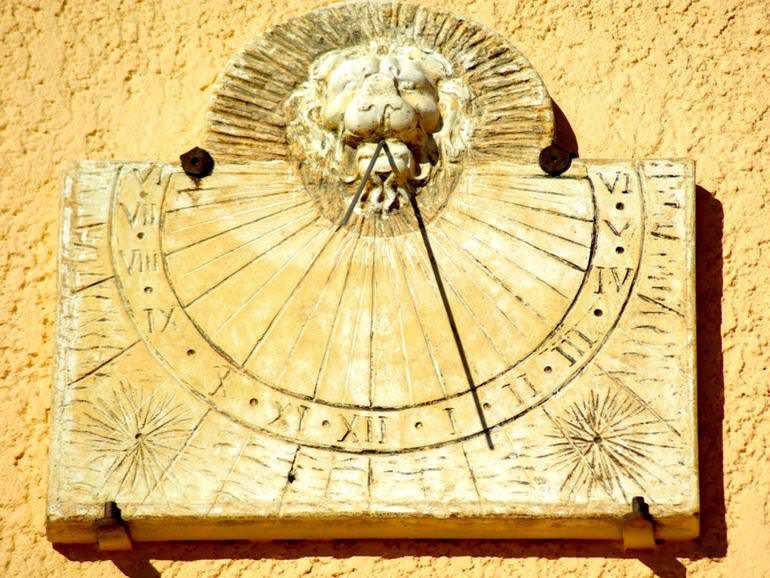

- When it is exactly 12 noon, the Sun is positioned in the southern direction for travelers in the Northern Hemisphere, and conversely, it is in the northern direction for travelers in the Southern Hemisphere;
- By remembering the exact location of the Sun when starting the journey, travelers can move back in that same direction at the end of the route;
- During summer noon, if a traveler stands with their back to the Sun, they will be facing North, with South behind them, East to their right, and West to their left.
It is worth noting that a regular mechanical clock adjusted to the local time can also be used to easily determine the directions of the world. In this case, you will only need the hour hand, as the minute and second hands are not necessary. The hour hand should be positioned as follows:

- Align it with the Sun on the horizon so that an imaginary line from the base of the hand runs directly towards the Sun, creating an angle.
- The resulting triangle formed between the number 1 and the hour hand should be divided in half and mentally extend the hand. The South will be in front and the North will be behind.
This method remains effective until one o’clock. After that, you will need to mirror the imaginary angle to the left and repeat similar steps.
Through the night sky and celestial bodies

When you find yourself lost at night with poor visibility of the stars or cloud cover, there is still hope for survival – by looking to the moon. The moon is usually highly visible, even if it’s not fully illuminated. You can estimate its diameter by dividing it into 12 segments and counting how many segments are visible. On the waning moon, you add this number to the current time, and on the waxing moon, you subtract it. The resulting figure corresponds to the hour when the moon’s direction aligns with the sun’s direction. Experienced adventurers always keep in mind:
- During the first quarter of the moon, its direction corresponds to the south until 7 pm;
- When the moon is full, its direction moves to the southeast until 10 pm;
- At 7 a.m., you can see the opposite quarter in the south.
To make navigation easier, remember this simple rule: when the crescent moon is in the waxing phase (forming a “P” shape), it is in the western part of the sky. During the waning phase (sickle on the left), it points east.
When the night sky is filled with bright stars, you can determine the correct direction by following any star. To do this, drive two sturdy sticks into the ground, about a meter apart, and then:
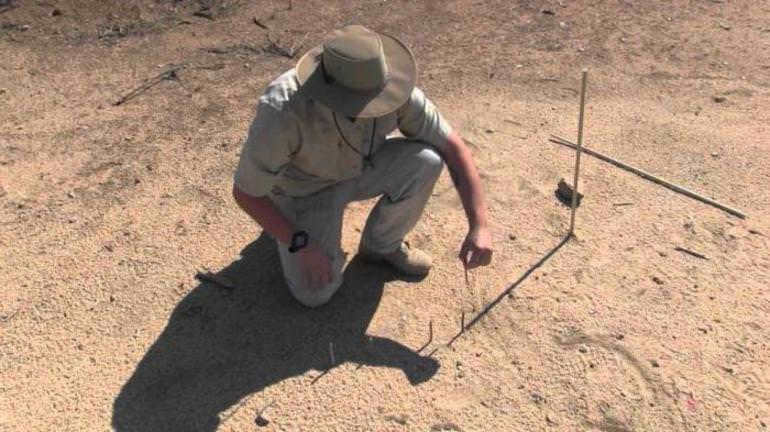
- Opt for the most prominent star that is difficult to lose sight of;
- Align it with the ends of both sticks;
- Stay put and wait for it to shift away from its fixed position.
The direction of displacement from the fixed point will indicate the cardinal directions. As our planet moves from west to east, the stars rotate in the opposite direction:
Ancient myths and beliefs
Throughout history, numerous myths and beliefs have been passed down from ancient civilizations. In Arab culture, it was believed that the luminous dot in the sky was a sacred coffin where the celestial warrior rested. On the other hand, Indian mythology described it as a young boy who fervently prayed to the gods without any distractions. These captivating names were given to celestial bodies by the ancient inhabitants of our planet. It is fascinating to note that even in ancient times, people possessed the knowledge to locate Polaris in the sky using the Big Dipper.
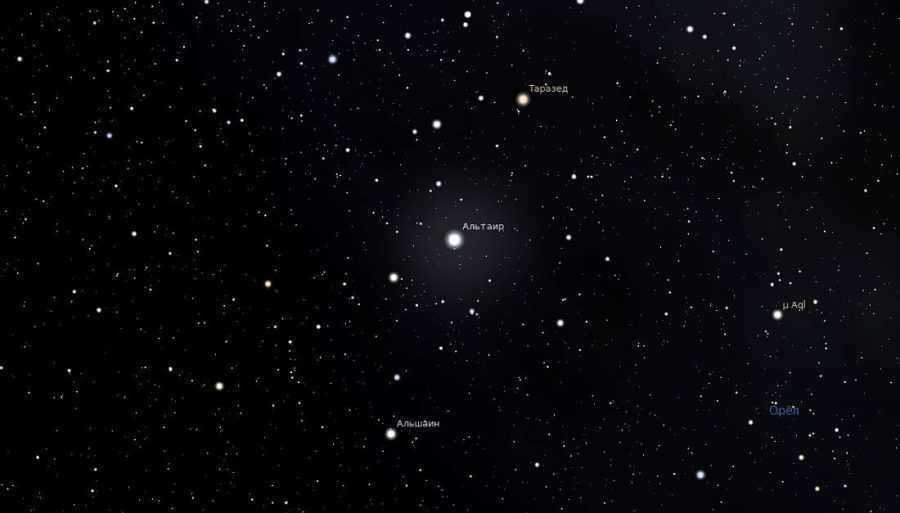
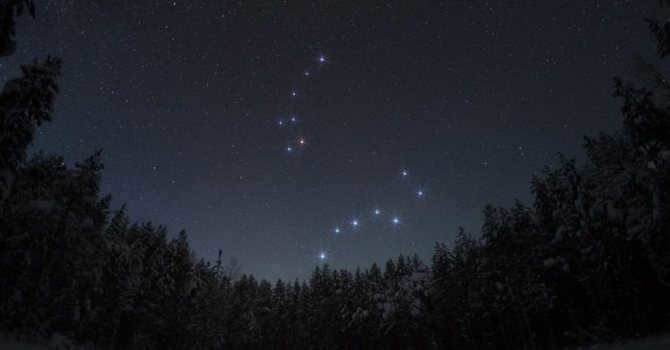

When you find yourself in an unfamiliar location during overcast conditions, the cardinal directions can be determined by observing local indicators. This task requires a certain level of knowledge and attentiveness.
Lichens and Moss
Moss and lichen consistently grow towards the north. These plant organisms dislike excessive heat and light, so they naturally gravitate towards the shadowy side. Occasionally, there may be some confusion in orientation, as moss can fully envelop an aged tree stump.

It is important to bear in mind that the soil on the southern side of any object is generally drier compared to the northern side. When approaching a moss-covered stump, for instance, the wetter area indicates the north direction.
An anthill in the forest is a useful landmark. These insects prefer warmth, so they construct their home in relation to the tree on the southern side. In the absence of a nearby tree, they pay attention to the shape of the anthill itself. The southern side of the anthill is flat, while the northern side is steep.
Grass
When you find yourself in the woods, it’s useful to navigate using the grass.
At the same time, it’s important to understand the characteristics of grass growth during different seasons:
- Spring. Plants are just starting to emerge. Their density is higher compared to the northern part of the grove.
- Early summer. Before the heat sets in, the grass forms a uniform carpet. However, upon closer inspection, it becomes evident that the density is higher on the southern side of the trees.
- During the peak of summer. Under the scorching sun, the grass starts to turn yellow and fade away. It lasts a bit longer in the northern direction.
Snow
During winter, a thick blanket of snow conceals all the prominent markers.

However, the polar star can provide guidance in the following ways:
- On the northern side, tree branches are more covered with snow compared to the southern side, which thaws faster.
- Conversely, on the slopes of ravines, there is less snow on the north side due to direct sunlight from the south.
- By observing the area under the trees, you can see that the snow melts on one side in the form of grooves that extend to the south. This is caused by the sun’s rays reflecting off the tree trunks from the southern side. On the northern side, scallops of snow are still visible.
The characteristics of mountain slopes
There is a noticeable difference in the direction of the slopes in the mountainous terrain. The slopes on the southern side tend to melt much faster than those on the northern side, where the snow layer remains for a longer period of time.
Having a good understanding of the terrain and being able to determine the cardinal directions is essential for navigating in any situation. Someone with these skills will always be able to find their way, even if they are lost in a forest. There are several ways to achieve this: using the sun or local landmarks during the day, and relying on the stars or moon at night.
Article design: Mila Friedan
Where can the star be found?
Once you have acquainted yourself with some of the facts and characteristics of the celestial object, you can start exploring the different ways to locate it. The most popular and well-known method is to locate the star by observing the nearby constellations. However, there are also other methods that some people prefer, such as using a map or compass.
There may be instances when you are unable to see the group of celestial bodies where the star is located, and this often leads to confusion in finding Polaris. To address this, let’s consider a few examples of how to locate this landmark.
Guidelines for Navigating on the Terrain
Understanding the guidelines for navigating on the terrain enables individuals to accurately locate a lost person. This skill is particularly useful in forested or mountainous areas. Navigating can be done at any time of the day without relying on electronic devices. Occasionally, a watch can serve as a helpful tool. The table provides information on the various methods for determining cardinal directions during different times of the day.
Studying Altair
In 1999, observations revealed that Altair’s brightness fluctuates within a range of 0.001 magnitude. In 2005, scientists determined that Altair is classified as a Beta Shield variable.
Similarly, during the 1960s, Robert Brown and his team measured the angular diameter of Altair, which was found to be 3 m/s. These same scientists hypothesized that Altair would contract due to its rotation speed, but the necessary equipment was unavailable to collect evidence.
Have you seen: Stephen Hawking – the extraordinary life of a brilliant scientist
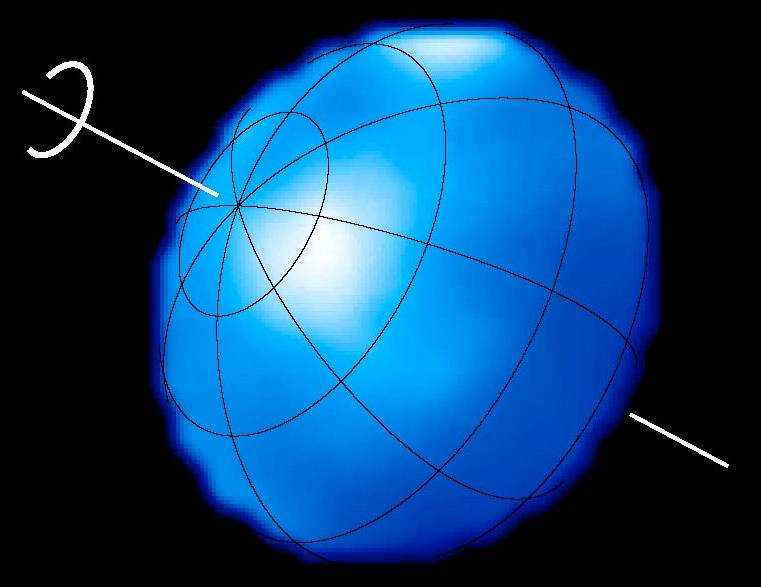
The research conducted by Gerard van Belle and his colleagues during the 1999-2000s focused on studying a star’s behavior and proposed a hypothesis that a star’s rapid rotation results in lower gravity and temperature near its equator, contrary to conventional beliefs. As a result, the equator of the star appears less bright, and this phenomenon is referred to as gravitational darkening.
In 2005, Dominicano de Souza continued the investigation by measuring gravitational darkening using the VINCI instruments on the VLT. Altair is one of the rare celestial bodies that have allowed scientists to capture images of their disks. This has enabled researchers to observe both the effects of surface compression and gravitational darkening.
Guidance in a specific direction
In certain situations, particularly in reconnaissance missions, the information gathered while planning a travel route and the measurements taken during the journey can also serve as a means of identifying targets.
For instance, while following a designated route, the reconnaissance team reaches an area located in quadrant 3098. They spot a target to the left, approximately 2.9 km away, with an angle of sight of 11-08. To designate the target, the team first determines their own location on the ground based on the information gathered from the route, and then locates the target by using the sight angle and range. If necessary, they can communicate the target’s location to a superior officer using this data. The receiver can easily mark the target on their map and then take appropriate action to either block or destroy it.
The enigmatic resident of the galaxy.
Altair, a celestial entity, remains elusive to scientists due to the limitations of modern equipment in comprehensively studying its properties and characteristics. Individuals born under the influence of this star are believed to possess qualities of endurance, honesty, and fortitude, making it a subject of fascination and legend.
- Altair’s ellipsoidal shape is a result of its rapid rotation.
- A groundbreaking photograph capturing Altair was finally obtained in 2007.
- The surface of Altair lacks a distinct coloration, exhibiting an irregular bluish-white tint.
- Altair is capable of altering its radius, which depends on its angle of orientation.
- The exact temperature of the luminary’s body is not known. Theoretically, this characteristic, along with gravity and luminosity, varies closer to the equator. It is directly influenced by rapid rotation and different geographical location.
- In 2005, barely visible disks of the star were captured in photographs.
- Within the Eagle constellation, a captivating spectacle unfolds: Altair is surrounded by a brilliant halo known as the Shining Eye. This nebula casts a shimmering radiance that can be observed through telescopes.
- The star’s name is frequently used in movies and games.
Did you see it? The Vela Pulsar.
According to a legend, the Eagle constellation was created by Zeus after Hercules killed his beloved bird. Altair is revered by the Japanese as the patron saint of lovers who are willing to make sacrifices and go to extremes for love.
Nowadays, if you find yourself disoriented, you no longer need to rely on traditional methods such as using the sun, trees, or other old-fashioned techniques. Thanks to navigational tools and smartphones, finding your way has become much easier. However, there are still occasions when these devices fail at the most inconvenient and unexpected times. That’s why it’s crucial to know how to navigate using improvised methods. One such method is by using the stars. The stars can help you determine the direction and guide you out of any unfamiliar location. In this article, we will explain how to navigate using the stars, focusing primarily on the Northern Hemisphere.

Finding the North Star
The initial step is to locate the North Star, also known as Polaris. This star is the most luminous in the constellation of Ursa Minor and can be found at the tip of its “tail”. Interestingly, Polaris acquired its name due to its constant proximity of one degree to the celestial North Pole. As a result, it appears motionless.
Interestingly, Ursa Minor, or the Little Dipper, is sometimes referred to as the Little Ladle since its arrangement of stars resembles a ladle.
Although the North Star is typically visible in the night sky, there are instances when it may be overlooked, particularly if one is unsure of where to look. Nonetheless, other stars can serve as helpful indicators in locating Polaris.
Most frequently, these are a pair of stars situated at the edges of the Great Bear’s tail, known as Merak and Dubhe. They can be found on the posterior side of the handle of the bear. By following a line from them to the ladle’s neck, one can easily spot the brilliant and gleaming Polaris.
Occasionally, during the night, the Great Ladle is positioned below the horizon. This typically occurs in early autumn. In such cases, we can locate the desired star by drawing a direct line through all the objects on the eastern side of the Pegasus constellation’s Great Square. These include the stars Algenib and Alferatz, as well as Kaf, which is located to the right in the Cassiopeia constellation.
Finding your latitude
If you have been successful in locating Polaris, the next step is to determine your latitude. This can be done by measuring the angle between Polaris and the northern horizon and recording it in degrees. For accurate measurements, it is recommended to use a quadrant or a sextant. The angle you obtain will correspond to your latitude north of the equator.
If you don’t have access to these instruments, you can still estimate the angle. Simply extend your clenched fist forward towards the horizon and stack your other fist on top of it. Continue this process until you visually align with the North Star. This angle will be approximately 10 degrees.
Search towards the south
In order to locate the southern region of the globe, begin by searching for Orion, a group of stars that resembles a curved hourglass shape. Within its “shoulder” area, you will find two stars named Betelgeuse and Bellatrix, while its “feet” are occupied by Cyphus and Rigel. The well-known “belt of Orion” consists of three stars: Alnitak, Alnilam, and Mintaka.
It is important to note that in the northern part of the world, this constellation is only visible during the winter and the early days of spring. Occasionally, it may also be seen in late autumn or during the final nights of summer, prior to dawn.
To locate the “Sword of Orion”, it would be helpful to search for a trio of stars: one of high luminosity, another of lower brightness, and one with indistinct contours. All of these celestial bodies will appear to be suspended from the central region of the constellation’s belt. This grouping of stars represents the sword, which will serve as your guide to the south.
This paragraph is intended for those who are located in or live in the southern hemisphere. In this situation, you should follow these steps:
- To start, you must locate the Southern Cross. This constellation consists of four stars that form the ends of the vertical and horizontal parts of the “cross.” Interestingly, the Southern Cross can be seen on the flags of Australia and New Zealand.
- In your mind, you should visualize a straight line running along these stars, which will form the vertical part of the cross. This line will point you towards the south.
If you are looking for a more precise way to determine your direction, try locating the stars Alpha and Beta Centauri. These two stars can be found to the west of the Southern Cross and can serve as a guide. Connect them visually by drawing a straight line, and then draw a perpendicular line from the center of this line until it intersects with the line we previously drew from the Southern Cross. This intersection point will then act as your southern pointer.

Locating the celestial equator
To locate the celestial equator, start by reacquainting yourself with the constellation Orion. Next, identify the star positioned on the far right of Orion’s belt. This star, known as Mintaka, is unique in that it both sets and rises within one degree of east or west. By following Mintaka’s direction, you will be able to determine the eastern and western regions of the world.
Finding your way using the stars
Discovering your direction by gazing at the stars is not a challenging task. Here’s a straightforward guide that you’ll find useful:
- Locate two sticks and insert them into the ground, positioning them half a meter apart.
- Using your eyes, locate any star that you can currently see. Any bright star will suffice.
- Align the star with the tops of both sticks.
- Now, you must be patient and wait for the star to move away from its initial position in relation to the sticks. The spot where the star “moves away” from its original position will indicate the desired direction. In simple terms: if the star rises, you are facing east; if it sets, you are facing west. If the star moves to the left, that signifies north, and if it moves to the right, that indicates south.
- It’s important to remember that Polaris is among the stars that are utilized in navigation not only by tourists but also by pilots and sailors worldwide. It serves as a universal guide for all nations. Interestingly, because it remains nearly stationary, you can determine latitude without knowledge of other star locations.
- The Big Bucket, or the Big Dipper, is also utilized for locating other stars in addition to Polaris. For instance, if you extend a straight line from the Little Dipper, passing through Merak and Dubhe, you will come across the star Regulus in the constellation Leo. Then, drawing an arc from these stars in the “handle” of the Big Dipper, you will spot Arcturus and Spica (Arcturus belongs to the Bootes constellation, while Spica is in Virgo).
- The misconception that Polaris is the brightest star in the sky is incorrect. In reality, it ranks as the 48th brightest star. The brightest star is actually Sirius, located in the constellation Canis Major.
Reminder to Myself
It is crucial to understand and remember that techniques and guidelines for determining travel direction using stars will eventually become outdated. This is due to the phenomenon known as Earth’s axial precession, where the position of the Earth’s poles gradually shifts over time.
As a result, certain stars will gradually move closer to the north or south celestial poles. Therefore, Polaris, which is currently well-known as the northernmost star, will only hold this position for a limited period of time – the next few hundred years.





